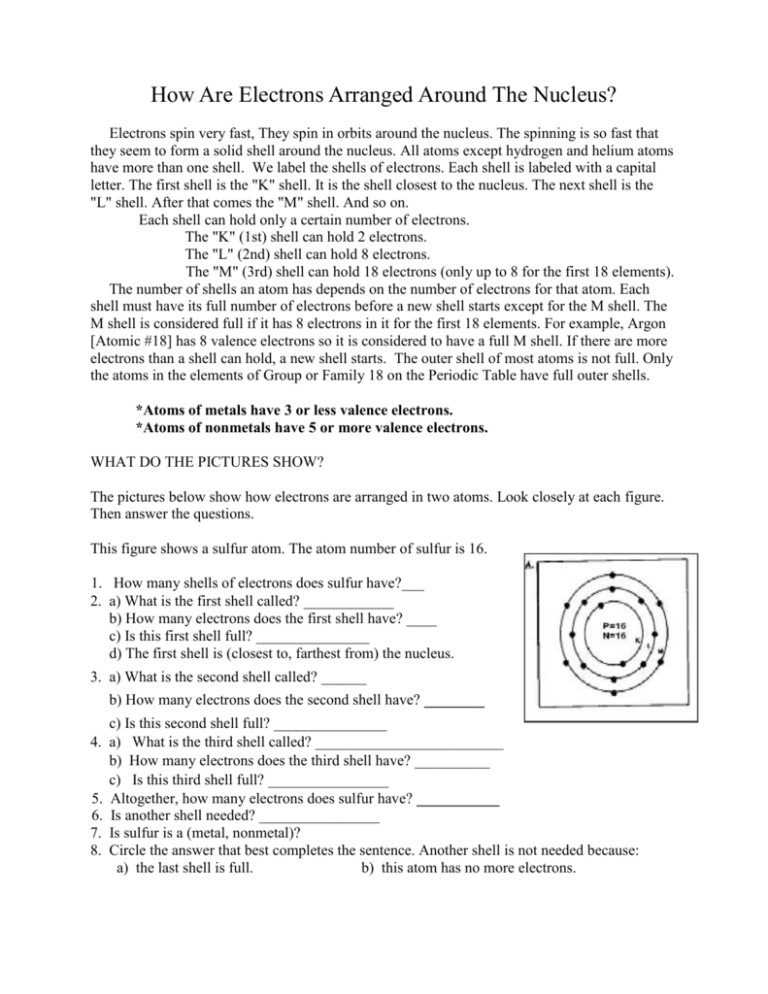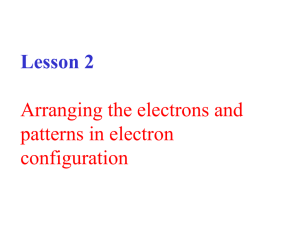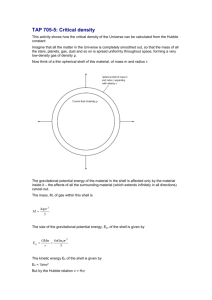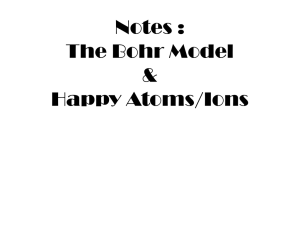How are electrons arranged around the nucleus
advertisement

How Are Electrons Arranged Around The Nucleus? Electrons spin very fast, They spin in orbits around the nucleus. The spinning is so fast that they seem to form a solid shell around the nucleus. All atoms except hydrogen and helium atoms have more than one shell. We label the shells of electrons. Each shell is labeled with a capital letter. The first shell is the "K" shell. It is the shell closest to the nucleus. The next shell is the "L" shell. After that comes the "M" shell. And so on. Each shell can hold only a certain number of electrons. The "K" (1st) shell can hold 2 electrons. The "L" (2nd) shell can hold 8 electrons. The "M" (3rd) shell can hold 18 electrons (only up to 8 for the first 18 elements). The number of shells an atom has depends on the number of electrons for that atom. Each shell must have its full number of electrons before a new shell starts except for the M shell. The M shell is considered full if it has 8 electrons in it for the first 18 elements. For example, Argon [Atomic #18] has 8 valence electrons so it is considered to have a full M shell. If there are more electrons than a shell can hold, a new shell starts. The outer shell of most atoms is not full. Only the atoms in the elements of Group or Family 18 on the Periodic Table have full outer shells. *Atoms of metals have 3 or less valence electrons. *Atoms of nonmetals have 5 or more valence electrons. WHAT DO THE PICTURES SHOW? The pictures below show how electrons are arranged in two atoms. Look closely at each figure. Then answer the questions. This figure shows a sulfur atom. The atom number of sulfur is 16. 1. How many shells of electrons does sulfur have?___ 2. a) What is the first shell called? ____________ b) How many electrons does the first shell have? ____ c) Is this first shell full? _______________ d) The first shell is (closest to, farthest from) the nucleus. 3. a) What is the second shell called? ______ b) How many electrons does the second shell have? ________ c) Is this second shell full? _______________ 4. a) What is the third shell called? _________________________ b) How many electrons does the third shell have? __________ c) Is this third shell full? ________________ 5. Altogether, how many electrons does sulfur have? ___________ 6. Is another shell needed? ________________ 7. Is sulfur is a (metal, nonmetal)? 8. Circle the answer that best completes the sentence. Another shell is not needed because: a) the last shell is full. b) this atom has no more electrons. This figure shows a neon atom. The atomic number of neon is 10. 1. How many electron shells does this atom have? ____ 2. a) What is the first shell called? _____ b) How many electrons does this shell have? ___ c) Is this shell full?_______ 3. a) What is the second shell called? ______ b) How many electrons does it have? ______ c) Is this second shell full? _____ 4. Altogether, how many electrons does this atom have?_____ 5. Is another shell needed? ____ Why? 6. Neon is a (metal, nonmetal). MATCHING Match the two lists. Write the correct letter on the line next to each number. 1. _____ between electrons 2. _____ 5 electrons 3. _____ orbit 4. _____ 12 electrons 5. _____ “K” shell a) closest shell b) path c) need three shells d) empty space e) need two shells HOW MANY SHELLS? How many shells are needed for each of the following? Write your answer in the space. 1. How many shells do 2 electrons need? _____ 2. How many shells do 4 electrons need? _____ 3. How many shells do 8 electrons need? _____ 4. How many shells do 16 electrons need? _____ 5. How many shells do 18 electrons need? _____ FILL IN THE ELECTRONS. Figure out how many electrons each of these atoms have. Then draw them in their proper shells. Make a small ball [*] to show an electron. An example has been done. Multiple Choice: In the space on the right, write the letter that best completes each sentence. _____1. Electrons move a. inside the nucleus. b. very slowly. _____2. Electrons move in paths called a. roads. b. orbits. _____3. An electron shell a. is solid. b. only seems to be solid. _____4. Electron shells seem to be solid because the electrons a. move very fast. b. have a minus charge. _____5. Which shell is the "M" shell? a. first b. second c. outside the nucleus. c. electrical charges. c. is tightly packed. c. balance the protons. c. third True or False: Write T on the line next to the number if the sentence is true. Write F if the sentence is false. 1. _____ 2. _____ 3. _____ 4. _____ 5. _____ 6. _____ 7. _____ 8. _____ 9. _____ 10. ____ Every atom has at least one electron. Every atom has at least two electron shells. The first electron shell is the "L" shell. The "L" shell can hold 8 electrons. The "L" shell always has 8 electrons. If there is an "L" shell, it means that the "K" shell is full. A full "K" shell has three electrons. A helium atom (atomic number 2) is a "full" atom. The first two shells must be full before a new shell is started. The heavier the atom the fewer the electrons







